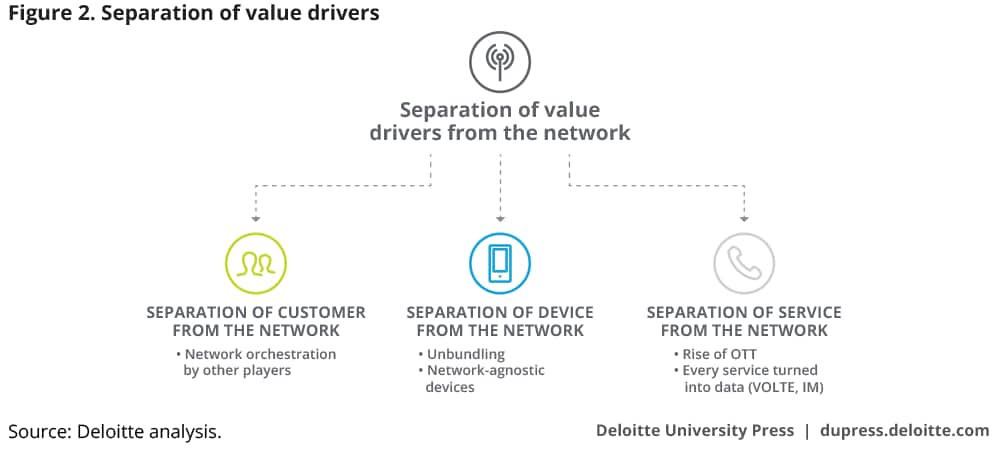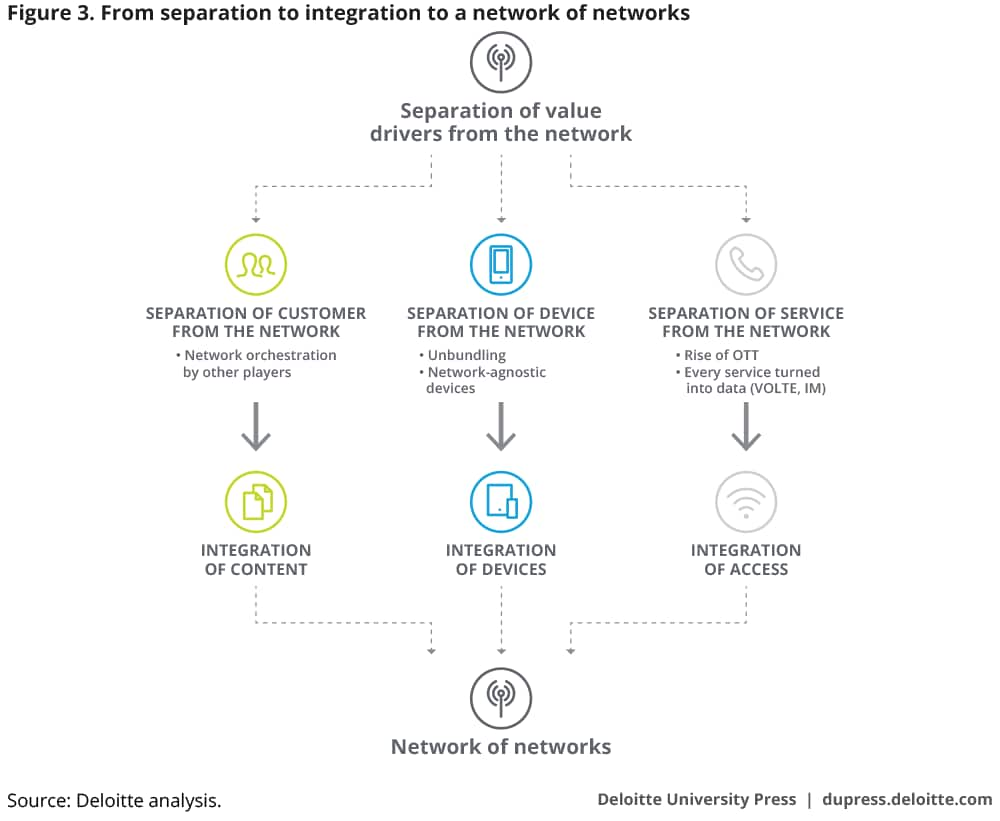A network of networks has been saved

A network of networks How will carriers handle the evolution to 5G?
22 June 2017
5G technology represents a real leap forward, promising vastly increased bandwidth. But carriers looking to capitalize with new offerings need to consider where and how to invest in equipment and more—and account for new security issues and rising consumer expectations for streaming video.

Introduction: Anticipating the next generation
In an era of ubiquitous connected devices and high-definition streaming video, everyone wants more bandwidth—immediately. To date, from individual connected devices to entire connected production systems, consumers and corporations alike have commonly depended on carriers. Wireless capacity has long evolved and increased alongside applications (see sidebar, “From 1G to 5G”), but the explosion of new uses can offer a real challenge. How can carriers keep up with demand? Telecom executives may wonder what’s next—and indeed, what’s next could well provide solutions to bandwidth issues.
The growth in wireless over the last two decades has been fairly linear, with subscribers growing steadily, revenues following subscribers, and carriers regularly increasing the amount of spectrum and towers they use to serve the market. This is likely all set to change, with the industry entering a nonlinear phase, and 5G technology likely to play a key role. The question is how carriers will handle the transition. Every generation, of course, has had its own share of leaders and laggards, and each generational leap has led to the development of new business models, with some companies capturing the maximum value while others miss (or lose their lead on) the opportunity.
The next phase of wireless technology is likely about more than increased speed: We believe that fifth-generation technology—5G—may be the first to realistically challenge fixed-line networks for even some of the most data-intensive applications. It represents something new.
We begin with a discussion about anticipated expectations of 5G core, followed by highlighting the changing market dynamics brought about as we move into 5G implementation. We conclude with three crucial areas for potential investment to capitalize on the upcoming opportunities presented by future evolution to a network of networks.
From 1G to 5G
From the first to the fifth, each generation of wireless service has enabled mobile technology to increase the quality of services, number of applications, and often satisfaction in customer experience, along with carriers’ operational effectiveness. Each generation has also brought about new waves of use cases, competitors, and prospects for the future. With 1G, which began more or less in the 1980s, analog systems focused on voice communications. While it allowed more capacity than the mobile radio networks in service at the time, analysts expected 1G to be a niche service with fewer than 1 million US users.1
By the time 2G came along in the 1992,2 there were 11 million mobile subscribers in the United States.3 2G systems used digital multiple access technology and introduced basic data capabilities; carriers optimized networks for much larger customer bases and use.
Carriers built 3G networks to overcome the challenges that previous-generation networks faced: low speed and incompatible technologies. Introduced commercially in 2002,4 3G offered higher transfer rates, improving data performance over cellular; the 2008 iPhone® mobile device 3G offered much faster web services,5 moving Internet use onto mobile networks, and was followed by Android 3G phones later the same year.6
Building on 3G’s success, carriers optimized 4G for data communications and made video viewing possible over mobile phone networks. Verizon launched 4G service in the United States in 2010, offering speeds up to 10 times that of 3G service.7 4G supports more data-intensive activities and offers better mobile broadband speeds.
While 4G aims for faster speeds in the over-the-air interface and radio-access-network technology, 5G is more complex. The technology is composed of two elements: a new way of managing mobile communications, commonly referred to as 5G core, and a new 5G radio access network. The core network is where customers and providers will likely see the services, plans, and content that truly differentiate the next level of network evolution. And this new technology will likely drive a push toward the industry growing in a less traditional and linear way, with some players able to leverage 5G’s advantages while others may struggle.
What can we expect from 5G?
Already with 4G, we have entered an era in wireless where the distinction in performance between mobile and fixed-line networks has become de minimis. According to Deloitte’s Global Mobile Consumer Survey,8 4G speeds have edged out Wi-Fi both at home and while “out and about.” But people want more, especially as video takes over their social media feeds. When asked about the need for even faster speeds (irrespective of the need to pay for it), just over 50 percent of people indicated that would be “very important” (27 percent) or “fairly important” (29 percent).
And consider that consumers are only beginning to incorporate many new data-intensive applications into their daily lives—most notably, Internet of Things (IoT) technology, linking dozens of personal devices simultaneously,9 and autonomous vehicles that demand constant connection with infrastructure, other vehicles, and drivers themselves. These and other connected technologies will likely require a much more robust network than exists today.10 Like each previous mobile generation, 5G is characterized by a core network and an access network (see figure 1). To meet the demands and fulfill the complex challenges of increased coverage, enhanced data throughput, higher speed with low latency, and managing complex relationships, the core—along with the access network of the mobile network—must evolve.11 In the longer term, the expected move to higher radio-access-network frequencies will likely necessitate a change in core network infrastructure to increase deployment flexibility and network dynamicity—for example, a likely move to cloud-based radio-access-network architecture. The transport layer of the core network—which aggregates, interconnects, and hands off the mobile traffic—should be sufficiently robust to enable services dynamically and in real time. It should also be massively scalable to handle traffic from various base stations.

To meet such complex infrastructure requirements, 5G is envisioned to require a new core network that can support a wide range of services, both existing and envisioned. This core network will likely necessitate the following:
Enhanced backhaul infrastructure. 5G is set to continue network densification via growth in the number of small cells: The small cell equipment market was around $2 billion in 2014 and is expected to reach $10 billion by 2019.12 The growth in small cells and increased data traffic will put more pressure on backhaul networks, thus revitalizing the growth for dormant or dark fiber,13 and indeed, wireless operators are investing billions of dollars in dark fiber-based backhaul solutions to meet the growth in data traffic.14 While fiber backhaul undoubtedly makes sense for some use cases, wireless backhaul will likely play a key role as well given its cost efficiency, speed of deployment, and recent advances in capacity. An interesting facet of this backhaul requirement: Cable companies and telcos’ traditional FTTN and FTTP architectures, with relatively low fiber counts and the need to traverse every street, may not be well suited to wireless backhaul needs. Small cells require much higher fiber counts (to allow dedicated fiber pairs to each cell) and need to traverse only a subset of streets—typically, 10 to 25 percent of the street miles in an area.
New infrastructure architecture. Previous generations have relied on a macro cell tower architecture supported by antenna systems and supplemented by small cells. By contrast, especially in higher-density areas, 5G coverage will likely depend on a mix of small cells and low-power femtocells in streetlamps and similar public locations. Networks will also likely rely on end-user devices such as micro cells and privately owned “homespots” to augment capacity and speed. This may result in a situation in urban areas where no user is ever far from a wireless access point. This can generally allow the use of higher frequencies, lower power levels, and unlicensed spectrum.
Merging of licensed and unlicensed spectrum and solutions. 5G mobile networks will lead to the emergence of combined spectrum approaches such as license assisted access (LAA).15 Though cellular frequency bands provide an exclusive medium to wirelessly connect consumers, it is Wi-Fi which accounts for majority of data traffic in unlicensed bands.16 Wireless networks today work predominantly on licensed frequency bands, but going forward technologies such as LAA and even Wi-Fi will help them in leveraging the unlicensed spectrum.17 Convergence of licensed and unlicensed bands through the bonding of mobile and Wi-Fi spectrum is emerging as a new development area for network operators.18
Utilization of high-frequency spectrum. One of the prominent use cases for 5G is “enhanced mobile broadband.” To meet the ultra-high broadband speeds envisioned for 5G, operators will likely have to shift to higher frequency spectrum or millimeter waves.19 The bands above 24 GHz are of particular interest: Specifically, the US Federal Communications Commission has allowed players to use 28 GHz for 5G. The band has also garnered interest from players in Korea and Japan. Meanwhile, the European Union is considering 24 GHz band for 5G pilot testing and an eventual rollout.20
Expansion of the LTE protocol into new areas. LTE Advanced Pro, the latest version, is a precursor to 5G, paving the way for the combination of licensed and unlicensed spectrum. LTE-U (unlicensed) is a similar technology that permits expansion of transmission bandwidth, thus enhancing speed and throughput. LTE-M is directed toward machine-to-machine/IoT communication and is specifically designed for low-power, low-bandwidth uses. 5G is expected to boost these new versions, especially with evolving use cases.21
A larger role for fixed network aggregation. Unlike previous generations of networks, in which fixed and mobile access networks evolved independently, 5G will likely need to be able to use any available access technology, utilize a broad range of spectrum, and have an access-agnostic architecture. The fixed and mobile broadband aggregation can help enable optimum use of network infrastructure: save costs while increasing efficiency of aggregation networks.
Massive device management. 5G will likely capitalize on the massive growth in connections per customer. Many American consumers and households already own a combination of smartphones, tablets, wearables, and other connected devices, and more are on the way. According to Cisco, analysts expect the average number of devices and connections per capita in North America to rise from 7.14 in 2015 to 12.18 by 2020.22 The growth in multi-device ownership and connections will likely increasingly consume and drive the data demand. To effectively deliver connectivity to billions of connected devices, the core network should have forward compatibility—and be scalable.
Multi-network convergence. All those devices and systems will likely demand coverage with zero geographical gaps and zero connectivity drops—no one wants to see, for instance, self-driving trucks lose connection while on the highway. The 5G ecosystem will likely need to manage diverse connectivity needs, from indoor communications to dense areas to sparsely populated areas. To provide a robust and efficient architecture, carriers should consider how to bring together 5G, LTE, and Wi-Fi, since only a multi-network convergence will likely be able to enable efficient spectrum and network management.
Improved management and security. 5G will likely bring its own new set of security requirements. Unlike previous generations of network, 5G is projected to support new types of devices and highly sophisticated and complex uses in diverse industry verticals, such as automotive and health care. The new devices—and the interactions between them—will likely encompass an extremely wide range of security requirements, meaning that the network’s security architecture of the 5G network will likely demand significant enhancement and a comprehensive approach to cybersecurity, aimed at making the network secure, vigilant, and resilient.23 Also, as the 5G network is expected to converge with multiple networks, it will likely operate in a highly heterogeneous environment. In such scenarios, enhanced security, authentication for various types of connected devices, and uninterrupted radio signals will likely be pivotal. The network should also be able to provide flexible security for specific applications, such as IoT applications.24
New radio air interface. 5G may eventually bring a new radio air interface designed to massively increase the data-carrying capabilities of spectrum in use, dramatically reduce latency and power consumption, and provide the ability for an exponential increase in the number of connected devices.25
A multiplicity of demands
So what capabilities should the new network bring consumers? In summary, we can foresee four potential capabilities with the introduction of 5G core.
• 5G’s introduction will likely accompany significant growth in the number of devices per customer. As the increase in devices leads to growth in data transmitted, more details and types of data will likely lead to greater demand for devices, thus creating a virtuous cycle. Many US consumers and households use multiple platforms and own a combination of smartphones, tablets, wearables, and other connected devices. The growth in multidevice ownership and connections could increasingly drive data demand.
• 5G will likely have to manage diverse connectivity needs coming from different types of connected devices, from low-power personal devices to autonomous vehicles that critically depend on uninterrupted connectivity. The service requirements may also differ, from supporting advanced mobile broadband services (high-definition content) to allowing remote operation of machinery. On top of it, consumers may elect to connect a mix of devices across multiple standards such as LTE or Wi-Fi—and most people will likely expect everything to connect seamlessly. An autonomous car might be on 5G network, but the passenger in it may rely on LTE for playing games or watching video. It will likely be imperative to provide and support such flexible requirements in conjunction with meeting different network access demands.
• 5G will likely have to manage much more complex sets of relationships between devices, and their relationships to users who insist on retaining control over them. Many consumers—even those with only a few devices—know how difficult it can be to manage, maintain, and link these devices. As the number of devices per person grows, so does the complexity to manage—which carriers will need to solve.
• 5G will likely be further driven by the demand for an increasingly digital lifestyle. 5G could usher in on-demand high-bandwidth services such as HD videos, games, and augmented- and virtual-reality content with an immersive experience. Entertainment will likely take a quantum leap in experience, and with access to a high-speed network, the demand for personalized services and streaming services on mobile devices may also accelerate.
From separation to integration: Technology shifts to economic dynamics
These four capabilities will likely create new opportunities for established telecom players as they try and generate new revenue streams and retain their customer relationships. It will likely also usher in opportunities for disruptive entrants into the ecosystem—a potential threat to the current players, driven largely by network value driver separation.
Separation of value drivers from the network
The evolution of mobile generations has seen a shift in the relationship between the user and the network operator. We can characterize this through three main events:
Separation of service. Applications and services are becoming agnostic of the mobile network on which they’re riding—for instance, consumers will likely increasingly use Internet Protocol-based instant messaging in lieu of more hardware-based short message service. Often termed over-the-top services, these come out of previous/existing wireless service generations but can be expected to continue/evolve into 5G.
Separation of device. Once inextricably linked in the US market, devices are increasingly becoming agnostic of particular carrier networks, with regulation and competition aiding a rapid shift away from this model. Consider the shift from subsidized mobile phones with service plans to those with equipment installment plans. Indeed, demand for buying devices under installment plans is increasing rapidly, with every leading telecom carrier generating higher equipment revenues from installment plans and leasing programs.26 This shift has the potential, however, to create less “stickiness” to any specific network provider and may impact the time that a consumer uses a particular device, potentially slowing down the rate of smartphone refresh.
Separation of customer. Customers are increasingly becoming disconnected to any specific type of network. While once they had to choose between carrier cellular and private/public Wi-Fi, customers now have multiple options that combine elements of both of these and may even make the network and equipment providing the signal virtually invisible to the person looking at her smartphone. We believe this is one of the big changes that 5G core specifically brings to the table.

Integration of value drivers into a network of networks
With the challenges and opportunities ahead for providers in the communications ecosystem, many driven by the emergence of the fifth generation of wireless services, what key considerations should executives make to maximize the opportunities and minimize the challenges?
Integration of access. Service providers will likely need to shift focus to provisioning, managing, and securing devices over network assets they own—and over assets that belong to others. This may require service providers putting significant efforts into layers 3, 4, and 5 of the seven-layer Open System Interconnection model—the application and presentation layers, as opposed to just the communications and transport layers. They will likely have to manage layer 1 and 2 assets they do not own but are contracted by either the customer or the carrier on a wholesale basis.
Integration of devices. Players in the telecom ecosystem should look at development of complex management and operating relationships between connected devices—and ways to simplify this management and integration. Currently, the user defines these relationships on a static basis, a situation that often becomes untenable when there are too many devices to manage. One possible solution: a device that the user can set up as primary controller and can then disseminate permissions to other users. As IoT technology increasingly becomes embedded in devices and is used to control and manage the user environment, we will likely have to move from this simple, static world to one where complex, flexible dynamic relationships can be established and changed. Another example would be a family car with an infotainment system synced to five different smartphones. When all five family members climb into the car, whose smartphone will the system choose for playing music? Who will decide the order of precedence? These are the sort of daily questions that are emerging as the number of connected devices grows along with linkages among them.
Integration of content. With a shift in entertainment media, we often see an accompanying link (and corresponding vertical integration) between content creation and distribution. It happened with cinema and the studio system, and television is following the same pattern, with over-the-air broadcasters creating significant content assets. With the switch to the multichannel universe, we see integrated models emerging again with the creation of cable channels (many by cable TV distributors) and satellite companies being vertically integrated. As this new “mega” model becomes mainstream, content may also be integrated. Today’s advertising market can be classified into three categories: traditional linear content (broadcast TV, cable channels), streaming services (Netflix), and immersive/interactive content (social media, digital, VR/AR). Trends show that advertising dollars are fast moving from traditional to interactive platforms where content dominates;27 hence, having distribution assets along with content assets can make a player better positioned in this emerging scenario. Our analysis found that with over 30 years of operation and 54 percent of viewing, traditional linear television generates the bulk of revenues, at around $0.37 per hour viewed. In contrast, over-the-top streaming services, with 15 percent of viewing, generate less than 10 cents per hour viewed. Up-and-coming immersive and interactive content (gaming, social media, virtual reality) already generates around 15 cents per viewed hour and has garnered 31 percent of viewing, quite possibly making it a new driver of entertainment revenues.28

What’s next for carriers?
Dealing with the shifting dynamics of network evolution may require thoughtful investments across multiple complexities. We believe that after many years of linear growth/change in devices, business models, cell sites, traffic, and users, the wireless ecosystem is poised for a period of exponential change. While the areas of investment abound, we see three main areas as turning points in the next one to two years.
Crack the envelopment code. There is a growing trend of offering direct services to customers by creating a wrapper around the core underlying services, networks, and platforms.29 This can be an effective strategy, particularly for companies that lack the physical assets to deliver the underlying services, networks and, platforms themselves but that desire to have a relationship with the end consumer. Consider Amazon Alexa, which provides insights to customers by using underlying network platforms and assets. The strategy avoids direct competition yet finds a way to generate value by forging a direct customer connection, allowing Amazon to have a play in the market without developing and maintaining its own platform. Telecom companies should likely seek to have their own strategy to address this trend and look at ways to develop new offerings without necessarily confronting—much less challenging—incumbents. One of the challenges for telecommunications companies can be that they have a national or regional focus whereas the companies that may envelope them usually have a global focus.
Become a connectivity provider. Consider focusing on the management of traffic as opposed to on-net carriage. Technologies such as LWIP (LTE WLAN integration) offer approaches to the three-pronged integration framework and subsequent traffic carried by LTE and Wi-Fi seamlessly for the end user. This and other emerging technologies can allow a carrier to manage and secure traffic and devices across both public wide area networks and private local area networks. Given the deployment of hotspots, homespots, and other sharing approaches to capacity, customers will likely be able to split traffic across a wide area network and a shared partition on a local area network. For carriers to be successful in this area, they will likely need to create management capabilities higher up the Open System Interconnection stack. (Technology companies will likely aim for the middle layers of the stack.) Carriers should look toward becoming full-fledged connectivity providers rather than just network transport providers, beginning by considering themselves full-stack organizations and looking toward working and managing network assets and devices of other companies on behalf of customers.
Manage multiple relationships. As applications and devices multiply, so can the number of relationships that any given customer has. Right now, for lack of better options, customers generally end up managing it all themselves, but as discussed, at some point the complexity becomes overwhelming in terms of time, resources, and knowledge/desire to do so. Going forward, then, service providers may want to play the role of managing the environment of multiple, disparate connected devices. Telecoms have an opportunity to be that service provider, but this will likely take a targeted strategy to choose which devices, platforms, and vendors can form the foundation of this strategy.
Shift mind-set from economies of scale to economies of scope. The advent of 5G is likely to catalyze a new wave of industry transformation driven by alliances, mergers, and acquisitions. Over the last two decades, as companies have sought greater economies of scale, the telecommunications industry has seen regular consolidation of like players. In this new era, the industry will likely be driven by a different kind of consolidation: one that increases companies’ scope and capabilities. In addition to the large-scale deals that have characterized the telecommunications space, we see room for smaller transactions as carriers look to acquire new capabilities and technologies from smaller players.
Conclusion: The 5G impact
Looking back over the roughly four decades of mobile wireless service evolution, each successive generation of technology created and lost fortunes for many providers based on incumbent and disruptive entrant strategies for that new technology’s capabilities. With an unprecedented level of complexity, functions, and upgrades in today’s telecom environment, 5G—across both the core and radio access network—stands to have a potentially greater impact on the overall ecosystem than any previous wireless generation.
We see the traditional outdoor system of cell sites and licensed spectrum being disrupted through the sharing of short-range wireless links between owners and wide area network users. We see convergence of supply between wireline and wireless broadband, as almost all devices become connected over short-range wireless. We see nonlinear growth in the number of devices for which users are responsible and a heavy device-management burden shift from the customer to the providers.
With an increasingly converged ecosystem of network and content players, an increasingly software-managed and defined physical networking space, and the demands and needs of consumers becoming complex enough that they no longer can manage individually, 5G and its associated technologies may have the power to reset the wireless landscape. The technology has the potential to shift the consumer relationship away from network providers yet at the same time provide a user experience that—if providers offer effective guidance and design—may help cement user relationships for the foreseeable future.
Given the speeds and experiences that analysts expect 5G to provide—meeting the needs of any reasonable use case today or in the near future—and the consumer “stickiness” that can be created by developing a one-time capability to manage the exploding number of connected devices, carriers appear to face a critical juncture. This can be your opportunity to step ahead of this quickly approaching next-generation wireless technology.
© 2021. See Terms of Use for more information.






